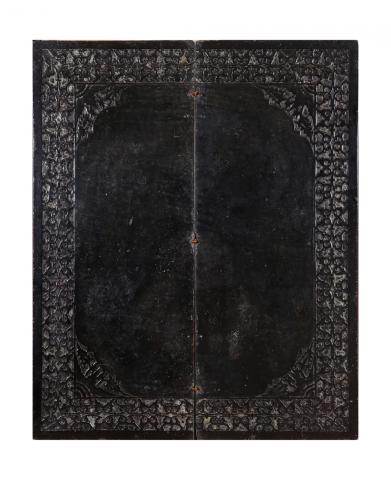Mesa de Engonços
Folding table (top)
Wood, lacquer, gold and iron
Kingdom of Pegu (present-day Burma, Myanmar), 16th century, second half
Dim.: 2.5 × 92 × 114 cm
Prov.: Former collection of J. Lico
F993
Mesa de Engonços (Tampo)
Reino do Pegu (actual Birmânia, Myanmar)
Séc. XVI – segunda metade
Madeira, ouro e ferro
Dim.: 2,5 × 92 × 114 cm
F993
This very rare folding table, i.e., the top, since it would be mounted on easels which have not survived, is made from exotic wood coated with black Southeast Asian lacquer or thitsi, not unlike the shield, would have also been decorated with gold leaf following the same Burmese technique (shweizawa). The gold decoration of vegetal motifs or rinceaux would be similar to that of other pieces produced in the Kingdom of Pegu for the Portuguese market, while the carved and incised decoration (better seen from the radiographs), although inspired by the decorative repertoire used in Chinese pottery of the Ming dynasty, namely blue and white porcelain, is clearly inspired by Renaissance entrelacs, following European engravings provided by Portuguese patrons.
Similar tables are recorded not only in the documents concerning the counts of Linhares, but also by household officers of Queen Catarina of Austria, in documents dated to 1562 and 1564 and published by Annemarie Jordan.
Of the few remaining examples, mention should be made to the table top (121 × 96.4 cm) said to have belonged to Cardinal Albert of Austria (1559-1621), viceroy of Portugal and today in the Kunstkammer of the Kunsthistorisches Museum, Vienna (inv. no. 4958), certainly of Chinese manufacture, and to another one published by Pedro Dias, now practically without its original gilded lacquer decoration, which, not unlike the present one, seems to be Burmese in origin.
H.M.C.
--
Esta muito rara mesa de engonços, ou de encartar, concretamente o tampo – dado que seria montada em cavaletes que não subsistem – de madeira exótica revestida a laca do Sudeste Asiático ou thitsi a negro, seria igualmente decorada a folha de ouro segundo a mesma técnica birmanesa (shweizawa) referida quanto ao escudo. A decoração a ouro de motivos vegetalistas ou rinceaux seria em tudo semelhante à de outras peças produzidas no reino do Pegu para o mercado português, enquanto que a decoração entalhada e incisa (melhor observada a partir das radiografias que dela se fizeram), embora provavelmente devedora também da decoração da cerâmica chinesa da dinastia Ming, nomeadamente aplicada à porcelana de azul e branco, inspira- se claramente nos entrelacs renascentistas, tal como divulgados por gravuras europeias levadas pelos portugueses.
Mesas semelhantes surgem, como se viu na documentação referente aos condes de Linhares, registadas entre 1562 e 1564 pelos oficiais da casa de D. Catarina de Áustria, em documentos publicados por Annemarie Jordan.
Dos raríssimos exemplares remanescentes pode-se citar a mesa (121 × 96,4 cm) dita do Cardeal Alberto de Áustria (1559–1621), vice-rei de Portugal, hoje na Kunstkammer do Kunsthistorisches Museum, Viena (inv. no. 4958) de fabrico seguramente chinês, e de uma outra publicada por Pedro Dias, já praticamente sem o seu original revestimento lacado e dourado, e que será, tal como a presente, uma produção birmanesa.
H. M. C
- Arte Colonial e Oriental
- Artes Decorativas
- Lacas

